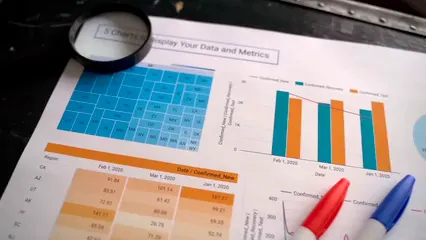Introduction
In our data-saturated age, business statistics serve as a beacon of clarity. With countless numbers and figures flying around like confetti at a wedding, the ability to extract meaningful insights from data is invaluable. This article aims to illuminate the vital role business statistics play in today’s decision-making landscape.
The purpose of this article is to highlight the significance of business statistics in crafting informed, strategic decisions. Statistics aren’t just numbers on a spreadsheet; they’re the backbone of effective business strategies. When communicated properly, these numbers can sway decisions, forecast trends, and even predict customer behaviors. Think of them as the magic words that turn confusion into clarity!
Why is communicating with numbers so critical? Because effective communication transforms raw data into insightful narratives. A well-crafted statistic can highlight a company’s growth, reveal market trends, or even predict potential pitfalls. Poorly presented data, however, can lead to misunderstandings and missed opportunities. Imagine presenting a crucial sales report that leaves your audience scratching their heads. Not ideal!
Now, let’s take a quick peek at the structure of this article. We’ll start by defining business statistics and exploring its key components. Following that, we will delve into the importance of statistical analysis in decision-making. We’ll also discuss the key concepts in business statistics, including descriptive and inferential statistics. Finally, we’ll wrap up by looking at best practices for communicating statistical findings.
So, grab a cup of coffee and get ready to dive into the fascinating world where business meets numbers!

Understanding Business Statistics
Definition and Scope of Business Statistics
Business statistics is the discipline that uses mathematical and statistical tools to analyze data for business decision-making. It provides essential insights into market trends, consumer behavior, and overall company performance. With the right statistical methods, businesses can make data-driven decisions that enhance efficiency and profitability.
Now, what does that mean in practice? Think of business statistics as the translator between numbers and actionable insights. It encompasses everything from data collection to analysis, interpretation, and presentation. Companies rely on these processes to transform heaps of data into meaningful information.
Key Components of Business Statistics
1. Data Collection: This is the foundation of the statistical process. Businesses gather data through surveys, experiments, and observations. The quality of this data is crucial. Poor data can lead to misguided conclusions. Want to ensure your data collection is top-notch? Consider utilizing a Pocket-sized notebook for data collection. It’s like having a trusty sidekick to jot down all those important numbers!
2. Data Analysis: Once the data is collected, it’s time to analyze it. This involves using various statistical techniques to uncover patterns and relationships. For instance, a retailer might analyze sales data to determine which products are flying off the shelves and which are gathering dust. For tips on effective data analysis, check out this resource on effective data analysis.
Understanding effective data analysis is crucial for businesses to make informed decisions. tips for effective data analysis in economics and statistics
3. Data Interpretation: Here’s where the magic happens! After analyzing the data, businesses interpret the results to make informed decisions. This step often involves comparing current data to historical trends or industry benchmarks.
4. Data Presentation: Lastly, presenting the data effectively is crucial. This step transforms the findings into a format that stakeholders can understand. Clear visuals, such as graphs and charts, can make complex data more digestible. After all, a picture is worth a thousand words!
In short, business statistics play a vital role in shaping strategies and driving success. By harnessing the power of numbers, businesses can navigate challenges and seize opportunities more effectively. So, buckle up as we continue our journey into the world of business statistics!

Importance of Business Statistics in Decision Making
Data-Driven Decisions
In the modern business landscape, data-driven decisions are the gold standard. Companies that rely on statistical analysis make informed choices that can lead to success. Think of it this way: would you jump into a pool without checking the water first? Of course not! Similarly, businesses must assess their data before making significant moves.
Statistical analysis helps identify trends, understand customer preferences, and predict future outcomes. For example, a retail chain analyzing sales data can pinpoint which products are hot sellers. With this information, they can stock up on popular items and avoid overstocking slow movers. It’s like knowing which flavors of ice cream will have customers lining up outside your shop!
Moreover, using statistics minimizes risks. A company can analyze past performance data to forecast future trends. This way, decisions aren’t based on gut feelings but on solid evidence. And evidence, my friends, is what separates the winners from the wannabes. If you’re looking to dive deeper into statistical methods, check out Statistics for Business and Economics by Paul Newbold. It’s like having a cheat sheet for all things statistical!
Real-World Applications
Business statistics has its fingerprints all over various industries. Let’s take a look at a few examples:
1. Marketing: In marketing, statistics play a pivotal role. Companies analyze customer demographics and preferences to craft targeted campaigns. For instance, if a brand discovers that 70% of its customers are millennials, it might ramp up social media advertising to reach this demographic effectively. To really get the most out of your marketing data, consider reading Naked Statistics: Stripping the Dread from the Data by Charles Wheelan. It’s an entertaining read that demystifies the world of statistics!
2. Finance: The finance sector thrives on statistics. Financial analysts utilize historical data to evaluate investment risks and returns. They might apply regression analysis to predict stock performance based on market trends. This analytical approach helps investors make sound choices, akin to having a crystal ball that actually works! For a comprehensive guide on statistical methods for finance professionals, check out this resource.
Statistical methods are essential for finance professionals to make informed decisions. statistical methods for finance professionals 2024
3. Operations: In operations management, statistics help streamline processes. By using statistical process control, companies can monitor production quality in real time. If defects start to creep in, managers can take corrective actions before they spiral out of control. It’s like having a safety net that catches you before you fall!
In conclusion, business statistics is not just a bunch of numbers; it’s a powerful tool that drives informed decision-making. By harnessing the power of data, organizations can navigate challenges, seize opportunities, and ultimately thrive in their respective industries.

Key Concepts in Business Statistics
Descriptive Statistics
Definition and Importance
Descriptive statistics is the art of summarizing and organizing data. It provides a clear snapshot of what the data looks like without diving into inferential aspects. Picture it as the appetizer before the main course; it sets the stage for deeper analysis. For a comprehensive guide on descriptive statistics in manufacturing, check out this resource.
Descriptive statistics is essential for summarizing data effectively. descriptive statistics in manufacturing plant
This type of statistics helps businesses understand their data’s shape and trends. For example, if you have a dataset of customer purchase amounts, descriptive statistics will help you see the average spend, the most common purchase amount, and how much variation exists in those purchases. It’s like getting a taste of a dish before ordering the full meal!

Techniques and Tools
Descriptive statistics employs several techniques to summarize data effectively:
1. Measures of Central Tendency: These measures tell us where the center of the data lies. The three main ones are:
– Mean: The average of all data points. It’s like the friendly neighborhood diner’s way of saying, “On average, people spend this much!”
– Median: The middle value when data is ordered. This is especially useful when outliers skew the mean. Think of it as the middle child, often overlooked but crucial for understanding balance.
– Mode: The most frequently occurring value. It’s like the popular kid in school—everyone notices them!
2. Measures of Variability: These measures help us understand how spread out the data is:
– Range: The difference between the highest and lowest values. It shows how much data can vary. If you’ve got a range of $100 to $1,000, that’s a lot of wiggle room!
– Variance: A statistical measure that describes how much data points differ from the mean. It’s like measuring how far each player on a sports team strays from the average skill level.
– Standard Deviation: This is the square root of variance and provides insight into data dispersion. A low standard deviation means data points are close to the mean, while a high one indicates more spread out data. Think of it as the difference between a well-behaved group of kids at a birthday party and a wild bunch running amok!
In summary, descriptive statistics is essential for businesses to make sense of their data. By utilizing these techniques, organizations can create a clear picture of their metrics, paving the way for informed decision-making and strategic planning.

Inferential Statistics
Overview
Inferential statistics enables us to make predictions about a population using sample data. Think of it as a fortune teller who uses a crystal ball, but instead of magic, we rely on numbers! This branch of statistics lets businesses estimate trends, behaviors, and characteristics of a larger group based on a smaller subset. It’s like sampling a slice of cake to guess the flavor of the whole.
By analyzing sample data, inferential statistics helps in making decisions with a level of confidence. This allows businesses to strategize efficiently without needing to survey the entire population. Imagine trying to count every single jellybean in a giant jar—exhausting, right? Instead, we can just count a handful and use that to estimate the whole jar’s contents.
Key Techniques
Several key techniques underpin inferential statistics. Let’s break them down:
1. Sampling Methods: This technique involves selecting a subset of individuals from a larger population. Random sampling is often the go-to method. It gives everyone an equal chance of being selected, making our estimates more reliable. Think of it as picking names from a hat—everyone has a fair shot!
2. Hypothesis Testing: Hypothesis testing is like a courtroom drama. It starts with a null hypothesis, which posits that there’s no effect or difference. We then gather data and test this hypothesis against an alternative hypothesis, which suggests there is an effect or difference. The outcome determines whether we “reject” or “fail to reject” the null hypothesis, guiding our conclusions. For insights on the problems associated with inferential statistics, refer to this resource.
Understanding the problems with inferential statistics is vital for accurate data interpretation. the problem with inferential statistics
3. Confidence Intervals: These intervals provide a range of values that likely contain the population parameter. For instance, if a business finds that 60% of surveyed customers prefer chocolate ice cream, a confidence interval might be 55% to 65%. This means we can be fairly confident that the true percentage of chocolate lovers in the entire population falls within this range. It’s like saying, “I’m confident it’ll rain today, but I’m also packing an umbrella just in case!”

Probability Theory
Basic Concepts
Probability theory forms the backbone of business statistics. It helps quantify uncertainty and make informed predictions about future events. Let’s break down some basic concepts:
– Experiment: Any procedure that yields one or more outcomes. Picture flipping a coin—heads or tails!
– Outcome: The result of a single trial of an experiment. Flipping heads? That’s an outcome!
– Event: A collection of outcomes. If we say “getting heads,” that’s an event consisting of a single outcome.
– Probability: This is the measure of how likely an event is to occur, ranging from 0 (impossible) to 1 (certain). If you flip a fair coin, the probability of landing heads is 0.5. Simple, right?

Probability Distributions
Probability distributions are essential in business statistics. They describe how probabilities are distributed over the values of a random variable. Here are three common distributions:
1. Normal Distribution: Often called the bell curve, this distribution is key in statistics. Many variables, like heights or test scores, follow this pattern. It means most data points cluster around the mean, with fewer occurrences as you move away. Businesses can use this to analyze customer behaviors or sales trends.
2. Binomial Distribution: This distribution applies to scenarios with two possible outcomes, such as success or failure. Think of a marketing campaign: did it succeed or fail? Businesses can use the binomial distribution to calculate the likelihood of achieving a certain number of successes in a given number of trials.
3. Poisson Distribution: This distribution is handy for counting the number of events that occur within a fixed interval of time or space. For example, how many customers visit a store in an hour? It helps businesses forecast demand and optimize staffing.

In a nutshell, probability theory equips businesses with the tools to make sense of uncertainty in their data. By understanding how likely events are to occur, companies can plan better and make smarter decisions.
Importance of Data Visualization
– Visual Representation: Data visualization is like putting on a pair of glasses for your data—suddenly, everything comes into focus! Charts, graphs, and tables transform complex data into easily digestible bites. Imagine trying to explain your favorite movie plot using only numbers. Confusing, right? Visual tools communicate trends, patterns, and outliers in a way that words alone simply can’t. A well-designed visual can tell a story in seconds, evoking emotions and sparking conversations. It’s the difference between showing a beautiful sunset and reading a weather report!

– Best Practices for Data Visualization: When creating visuals, keep it simple. Use clear, concise labels, and choose colors wisely—like picking an outfit for a first date! Avoid clutter; too much information can lead to chaos. Each visualization should have a purpose. What story do you want to tell? Ensure your visuals are accessible. Consider colorblind-friendly palettes and readable fonts. Lastly, test your visuals with real users. If they don’t get it, you might need to rethink your design. Remember: the goal is clarity, not confusion!
Effective Communication of Statistical Findings
– Storytelling with Data: Telling a story with data is like crafting a delicious recipe. Start with a compelling introduction—set the scene with your findings. Use data to build your narrative, guiding the audience through your insights. Highlight key points with visuals, making it relatable. For example, instead of saying, “Sales increased by 20%,” tell your audience how that growth impacted a local community. Did it lead to new jobs? Did it change lives? A narrative makes numbers resonate, turning dry statistics into engaging tales.
– Common Pitfalls: Presenting data can be tricky. One common mistake is overwhelming your audience with too much information. Keep it focused! Another pitfall is using misleading visuals. A graph may look impressive but can distort the truth. Always represent your data honestly. Beware of jargon; using complex terms can alienate your audience. Instead, speak their language! Finally, don’t skip the context. Explain why the data matters. Without context, your findings are like a song without a melody—lacking harmony and meaning.

Tools and Software for Data Analysis and Visualization
– Popular Tools: In the world of business statistics, tools are essential. Excel reigns supreme for its simplicity and versatility. You can whip up quick analyses and stunning visuals without breaking a sweat. For those seeking a deeper dive, R and Python are the superheroes of data analysis. They offer powerful packages for statistical modeling and visualization. Imagine having a Swiss Army knife in your toolkit—it can do everything! These tools empower businesses to turn raw data into actionable insights, helping decision-makers steer the ship in the right direction. If you want to get started with R, consider picking up R Programming for Data Science by Roger D. Peng!
– Case Studies: Companies like Netflix use these tools to analyze viewer behavior. By understanding what keeps audiences glued to their screens, they craft engaging content. On the other hand, retail giants like Walmart harness the power of data visualization to optimize inventory management. They track sales trends, ensuring that the right products are on the shelves at the right time. These examples illustrate how effective tools transform data into stories that drive success. With the right software, businesses can turn numbers into narratives that influence strategy and growth.

Challenges in Business Statistics
Misinterpretation of Data
Issues with Misleading Data
Data misinterpretation is a slippery slope. Even the most brilliant statistician can slip on this banana peel! Misleading data can arise from various sources, such as small sample sizes, biased surveys, or cherry-picked statistics. For instance, if a company claims a 300% increase in sales, it might sound impressive. But wait—if they were only selling three items last year, that’s only nine this year! Yikes! Misleading data can lead to misguided decisions, wasted resources, and a shattered reputation.
Imagine a marketing team basing their next campaign on inflated statistics. They might target the wrong audience, resulting in wasted ad spend. Or worse, they could launch a product that nobody wants. The consequences of misinterpreting data can snowball, leaving businesses scratching their heads and wondering where they went wrong. For a more structured approach to understanding these pitfalls, consider reading How to Lie with Statistics by Darrell Huff.

Importance of Context
Context is king when it comes to data interpretation. Without it, numbers are just lonely digits floating in the ether. Providing context helps frame the data, making it relatable and understandable. For example, consider a company reporting a 15% drop in customer satisfaction. Without context, this could be alarming. But if they reveal it’s following a major software update, it might be a temporary blip rather than a permanent issue.
By contextualizing data, businesses can avoid knee-jerk reactions based on incomplete information. A well-rounded understanding allows decision-makers to gauge the significance of statistical findings, leading to more informed actions. So, always remember: data without context is like a joke without a punchline—confusing and ineffective!
Ethical Considerations
Ethical Use of Statistics
Ethics in statistics isn’t just a nice-to-have; it’s a must-have! Statisticians and data analysts carry the weight of responsibility. Their findings can influence decisions that affect employees, customers, and entire industries. Misrepresentation of data, whether intentional or not, can lead to severe consequences.
Imagine a company manipulating statistics to show a positive impact of a product that’s actually harmful. Not only is this unethical, but it could also lead to legal issues and a public relations nightmare. Ethical use of statistics means being transparent about data sources, methodologies, and any limitations. It’s about maintaining integrity and trust in the business landscape. After all, nobody likes a data charlatan!
Data Privacy Concerns
In the age of big data, data privacy is a hot topic. With laws like GDPR tightening the screws, businesses must tread carefully. Collecting and analyzing data comes with a moral obligation to protect individuals’ privacy. Failing to do so can result in hefty fines and damage to reputation.
Consider this: a company collects customer data for targeted advertising but fails to secure it properly. A data breach occurs, exposing sensitive information. Not only do customers feel betrayed, but the company also suffers financial and reputational damage. It’s a lose-lose situation! Ethical data practices involve obtaining consent, anonymizing data when possible, and ensuring secure storage. Adhering to privacy laws isn’t just about compliance; it’s about building trust with customers.
By addressing these ethical considerations, businesses can foster a culture of responsibility in their statistical practices. After all, with great data comes great responsibility!

Please let us know what you think about our content by leaving a comment down below!
Thank you for reading till here 🙂
All images from Pexels




